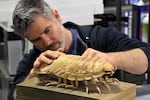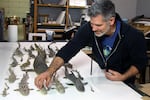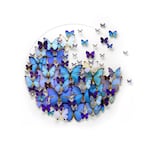Forget what you know about taxidermy.
The Oregon artist Christopher Marley has pioneered cutting-edge techniques to transform poisonous snakes, tropical fish and exotic insects into works of high art, and now 400 of his creatures are going on display in a major exhibition outside Miami at the Wiener Museum of Decorative Art and the Gallery of Amazing Things.
On the Saturday before Thanksgiving, Marley and his team were packing up a prehistoric looking hornbill and a 10-foot-long frame full of a dozen reef sharks — the last few works to ship to the museum for his December opening — when he realized that he’d forgotten to frame a foot-long isopod.

Christopher Marley works on a frozen isopod at his Oregon studio.
Aaron Scott / OPB
“It's like a giant pill bug or potato bug or roly-poly, depending on where you're from,” he said, pulling a creature from the freezer that looked like something right out of “Starship Troopers” or some other sci-fi movie about monster bugs that eat people.
“They're able to do some damage. There have been fish caught, that were living, and they’ve found giant isopods in their throats and their guts, eating them from the inside out. So they are the stuff of nightmares, that's for sure.”
In Marley’s hands, they are also the stuff of beauty. He preserves all sorts of beasts and poses them in sleek frames against white backgrounds. Chromatic beetles cluster like mandalas, snakes coil like intricate pendant necklaces, macaws spread their rainbow wings, and octopuses twist and curl, so voluptuous they seem to be alive.

Christopher Marley arranges reef sharks onto a mat.
Aaron Scott / OPB
“‘Pheremone’ and Chris’s next book, 'Biophilia,’ are both tremendous references for design,” said Mark Parker, the CEO of Nike and a collector of Marley’s art. “Chris’s subject matter and imagery have inspired Nike’s design work on color and texture, on high-performance track spikes for Olympic athletes, and even new interpretations of classic styles like the Nike Air Max.”
That’s right. U.S. athletes at the 2016 Summer Olympics wore track shoes inspired by Marley’s image of a sagra buqueti beetle.
Marley grew up wanting to be an artist, but, gifted with a square jaw and biceps like boa constrictors, he became a model. As he hopscotched the globe for photo shoots, he collected insects and arranged them into iridescent kaleidoscopes. When Marley’s fiancé convinced him to show them to several stores in Los Angeles in 1998, the orders came flying in. So he quit modeling and started backtracking through the countries he’d visited, sourcing sustainable insect collectors.
Then, Marley branched into sourcing and framing beautiful shells. Then minerals. Then parrot feathers from his father’s aviaries, because, it just so happens that his dad is a breeder of rare color mutations of Australian parrots.
“Throughout my whole life, we’d always had dead birds in our freezers,” said Marley. “My dad could just not bear to throw these beautiful birds away. And that’s when I realized that if my dad does this with birds, I’ll bet you that most people that deal with any type of organism that they’re in love with, that they probably do the same thing.”
Marley has since built a network of breeders, zoos, aquariums and importers that send him their dead. He says that he only uses reclaimed specimens that have died from natural causes or been caught as fishing bycatch — he doesn’t buy from hunters.
The sharks in the frame that he’s packing up? Some came from aquariums, but others he bought in a fish market in Borneo. “So the trawlers come in and they bring up everything from the ocean floor, unfortunately,” he said. “And there was a massive basket of these gorgeous sharks, and I just couldn’t stand thinking of them getting chopped up and boiled up for soup, so I bought and overnighted them. These things that you only experience in a culinary platter, we try to make it so you experience it in an aesthetic fashion.”
Hundreds of specimens end up crowded in freezers scattered around Marley’s 10,000 square-foot warehouse in Salem, Oregon, and his studio in Kuala Lumpur (which handles many of his insect pieces) — in various stages of decay.
“This is all pythons and venomous reptiles — and baby alligators apparently,” Marley said, opening one freezer and pulling out ziplock bags containing green mambas and canebrake rattlesnakes, in various stages of decay.
To preserve them, Marley has pioneered a complex process involving meticulous fat removal, chemical injections, and freeze-drying that allows him to frame dry animals, including many that scientists generally keep in liquid, such as sharks and cephalopods.

Christopher Marley has pioneered a way to freeze-dry animals that makes them look alive in the frames.
Courtesy Christopher Marley Studio
In one corner, two large barrel-shaped freeze dryers have shelves of desiccated snakes, coiled just so by Marley to emphasize what he calls their “dangerous beauty.”
“I don’t see anybody doing these sorts of things,” said Kenneth Filchak, a biology professor at Notre Dame who uses Marley’s work to inspire students. “He might just be the Michelangelo of this sort of presentation and preservation.”
Working under the name Pheremone Design, Marley sells the creations in dozens of high-end stores and has shown them in natural history and art museums alike, including a recent LACMA exhibition curated by the film director Guillermo Del Toro called “At Home with Monsters.” Marley’s work has also appeared on the covers of biology textbooks and in Marley’s own best-selling art books.
Marley’s exhibition, “Biophilia: A Dialogue with Art, Nature and Science,” running in Dania Beach, Florida, through March 31, is two prong. Downstairs at The Gallery of Amazing Things, hundreds of Marley’s pieces will be arranged into sections focused on biodiversity, the science of color, and his particular approach to design. Then upstairs at the Weiner Museum of Decorative Arts, they will be shown in contrast to the museum’s extensive collection of ceramics and art glass.
“There was a lot of pleasure and joy in finding all the different parallels,” said Louise Irvine, the executive director of WMODA who curated the show. “Chris does a lot of work with iridescent creatures, so we made a section devoted to fire and iridescence since a lot of colors that appear on ceramics and glass surfaces have that iridescence.”
Likewise, she saw connections between Marley’s work involving sea creatures and shells with the glass art of by Dale Chihuly. “Art glass has so many parallels with water,” she said. “We were picking up on the colors and forms of glass with the tentacles and forms of fishlike creatures, that are all coming together in the exhibit.”
By isolating organisms from their natural surroundings, Marley hopes viewers will see them anew.
“So it’s this juxtaposition of geometry and perfect symmetry and wild, arcane organism,” said Marley. “I think that the greatest power of the work itself is helping people to open their eyes to the varieties that exist in the natural world. Once you get this sense that there’s so much more that I didn’t know about, it just feeds this desire to see more and more and more.”
As for Marley’s next project? He’s heading deep into a Malaysian jungle to hunt for a never-before-preserved species of the corpse flower.

